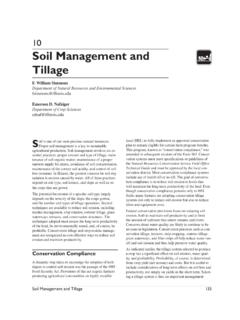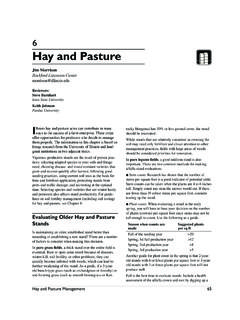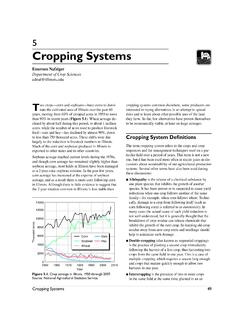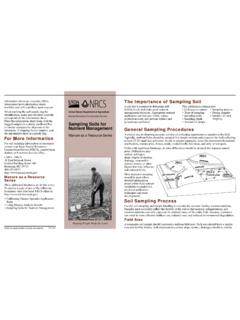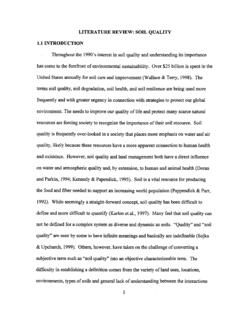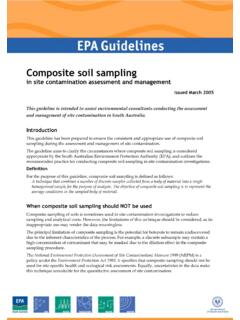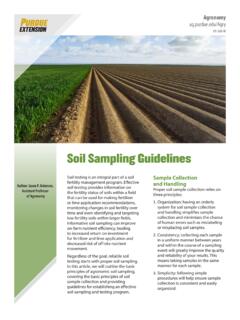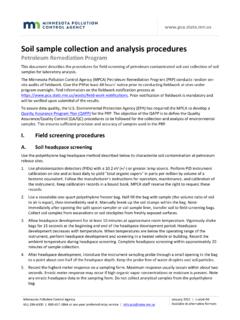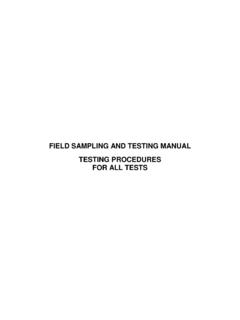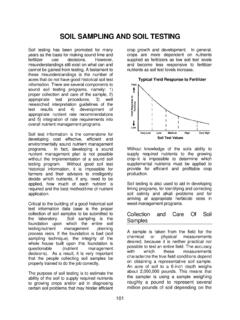Transcription of 8 Managing Soil pH and Crop Nutrients
1 Managing soil pH and Crop Nutrients 91 The inherent complexity of crop production systems requires integrating many factors to ensure maxi-mum crop yields with the least risk to the environment. Assessing present- and reserved-nutrient status of the soil , understanding its nutrient-release and nutrient-holding capacity, and knowing the plant and environmental factors that impact nutrient availability are necessary to guide fertilization rates, sources, and method of application of additional Nutrients . The information here is intended to provide fundamental principles to help the reader under-stand what to do, and why, when making management decisions related to phosphorus (P), potassium (K), sec-ondary macronutrients (calcium [Ca], magnesium [Mg], and sulfur [S]), micronutrients (boron [B], chlorine [Cl], copper [Cu], iron [Fe], manganese [Mn], molybdenum [Mo], and zinc [Zn]), and pH.
2 Factors Impacting Plant-Nutrient AvailabilityNutrient availability can be impacted by soil chemical and physical properties, including parent material and naturally occurring minerals; amount of organic matter; depth to bedrock, sand, or gravel; and permeability, water holding capacity, and drainage. In addition, environmen-tal conditions and crop characteristics have an important impact on nutrient availability. It is not unusual for crops in fields or portions of fields to show nutrient deficiencies during periods of the growing season, even where an ad-equate nutrient management plan is followed.
3 The fact that Nutrients are applied does not necessarily mean they are 8 Managing soil pH and Crop NutrientsFabi n G. Fern ndezDepartment of Crop G. HoeftDepartment of Crop Plants obtain most of their Nutrients and water from the soil through their root system. Any factor that re-stricts root growth and activity has the potential to restrict nutrient availability. This is not because Nutrients are not plant-available in the soil , but because the ability of the crop to take up those Nutrients is restricted. Understanding how these factors can cause nutrient deficiency in crops is important to avoiding excessive concern about the need for additional fertilization when a sound nutrient program is already in place.
4 soil compaction can limit or completely restrict root pene-tration and effectively reduce the volume of soil , including Nutrients and water, which can be accessed by the plant. To limit soil compaction, avoid entering fields that are too wet, and minimize the weight per axle by decreasing load weight and/or increasing tire surface area in contact with the soil . Planting when soils are wet can create a com-pacted wall next to the seed that will prevent the seedling from developing an adequate root system. Tilling wet soils will result in clods that become hard and dry out quickly on the surface, preventing roots from accessing resources inside the water content is critical not only to supply the water needs of the crop but also to dissolve Nutrients and make them available to the plant.
5 Excess water in the soil , how-ever, depletes oxygen (O2) and builds up carbon dioxide (CO2) levels. While O2 is needed by roots to grow and take up Nutrients , high CO2 levels are toxic. Temperature is important in regulating the speed of soil chemical processes that make Nutrients available. Under cool soil temperatures, chemical reactions and root activ-92 Illinois Agronomy Handbookity decrease, rendering Nutrients less available to the crop. Portions of the plant Nutrients are taken up as roots extract soil water to replenish water lost through the leaves.
6 Cool air temperatures can lower evapotranspiration and reduce the convective flow of water and Nutrients from the soil to the intensity is low on cloudy days. Low light intensity reduces photosynthetic rates and nutrient uptake by the crop. Since low light intensity sometimes occurs when soils are waterlogged or temperatures are cool, cloud cover can exacerbate the capacity of the crop to take Nutrients . Diseases and pests can have an important impact on crop-nutrient uptake by competing for Nutrients , affecting physiological capacity (such as reduction in photosynthesis rates), and diminishing root parameters through root prun-ing or tissue Nutrient AvailabilitySoil AnalysisSoil tests are not perfect, so a soil test value should be considered not a single value, but rather a value within a range.
7 There are multiple reasons why soil tests are not perfect: a soil test represents a measurement at one point in time, while a crop takes Nutrients through an extended period, and typically under very different soil -water and temperature conditions than at the time of sampling ; the information generated typically comes from a sample from the plow layer, but the crop roots extract Nutrients below that layer; laboratory precision is typically within 5% to 10% of the true value. Despite these imperfections, soil testing is the most important guide to profitable applica-tion of phosphorus, potassium, and lime because it pro-vides a framework for determining the fertility status of a field.
8 In contrast, plant tissue analysis is typically more reliable than soil testing for secondary macronutrients and micronutrients. Since crop yield response to application of these Nutrients has been very limited in Illinois, there is not a large enough database to correlate and calibrate soil -test procedures. Ratings in Table can provide a perspective on the reliability, usefulness, and cost effec-tiveness of soil tests as a basis for planning a soil fertility and liming program for Illinois field crops. Traditionally, soil testing has been used to decide how much lime and fertilizer to apply to a field.
9 With increased emphasis on precision agriculture, economics, and the envi-ronment, soil tests are also a logical tool to determine areas where adequate or excessive fertilization has taken place. In addition, they are used to monitor the impact of past fertility practices on changes in a field s nutrient status. Of course a soil test report can only be as accurate as the sample sent for analy-sis. In fact, the spatial variability of avail-able Nutrients in a field makes soil sampling the most common and greatest source of error in a soil test. To collect samples that provide a true measurement of the fertility of an area, one must determine the sampling distribution; collect samples to the proper depth; collect samples from precisely the same areas of the field that were sampled in the past; and collect samples at the proper soil .
10 A soil probe is the best implement for taking soil samples. An auger or a spade can also be used as long as care is taken to collect an exact depth with a constant slice thickness (Figure ). A soil sample, or sampling point in the field, should be a composite of at least five soil cores taken with a probe from within a 10-foot radius around the sampling point. composite samples should be placed in bags with labels identifying the places where the samples were collected. sampling distribution. The number of soil samples taken from a field is a compromise between what should be done (information) and what can be done (cost).
